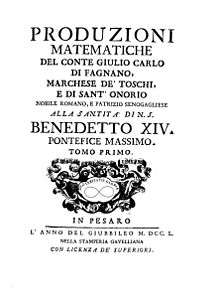Giulio Carlo de' Toschi di Fagnano
Giulio Carlo, Count Fagnano, and Marquis de Toschi (December 6, 1682 – September 26, 1766) was an Italian mathematician. He was probably the first to direct attention to the theory of elliptic integrals. Fagnano was born in Senigallia.
Work

Fagnano is best known for investigations on the length and division of arcs of certain curves, especially the lemniscate; this seems also to have been in his own estimation his most important work, since he had the figure of the lemniscate with the inscription: "Multifariam divisa atque dimensa Deo veritatis gloria", engraved on the title-page of his Produzioni Matematiche, which he published in two volumes (Pesaro, 1750), and dedicated to Pope Benedict XIV. The same figure and words "Deo veritatis gloria" also appear on his tomb.
Failing to rectify the ellipse or hyperbola, Fagnano attempted to determine arcs whose difference is rectifiable. The word "rectifiable" meant at that time that the length can be found explicitly, which is different from its modern meaning. He also pointed out the remarkable analogy existing between the integrals which represent the arc of a circle and the arc of a lemniscate. He also proved the formula
where i stands for .
His works were collected and published in two volumes at Pesaro in 1750.
Some mathematicians objected to his methods of analysis founded on the infinitesimal calculus. The most prominent of these were Viviani, De la Hire and Rolle.
Life
He made his higher studies at the Collegio Clementino in Rome and there won great distinction, except in mathematics, to which his aversion was extreme. Only after his college course he took up the study of mathematics. Later, without help from any teacher, he mastered mathematics from its foundations. His most important research was published in the Giornale de' Letterati d'Italia.
One of Fagnano's sons, Giovanni Fagnano, also became a mathematician.
References
- An original entry was based on the book A Short Account of the History of Mathematics (4th edition, 1908) by W. W. Rouse Ball.
![]() This article incorporates text from a publication now in the public domain: Herbermann, Charles, ed. (1913). "article name needed". Catholic Encyclopedia. New York: Robert Appleton.
This article incorporates text from a publication now in the public domain: Herbermann, Charles, ed. (1913). "article name needed". Catholic Encyclopedia. New York: Robert Appleton.
External links
- O'Connor, John J.; Robertson, Edmund F., "Giulio Carlo de' Toschi di Fagnano", MacTutor History of Mathematics archive, University of St Andrews.